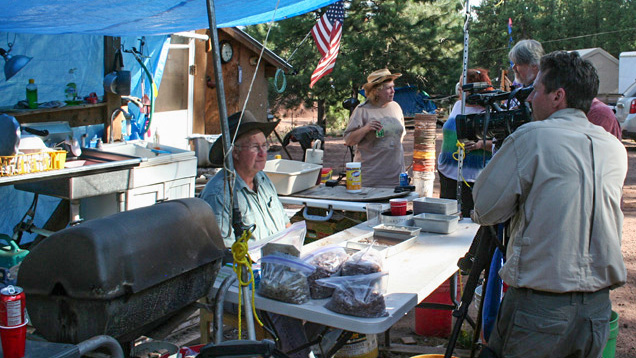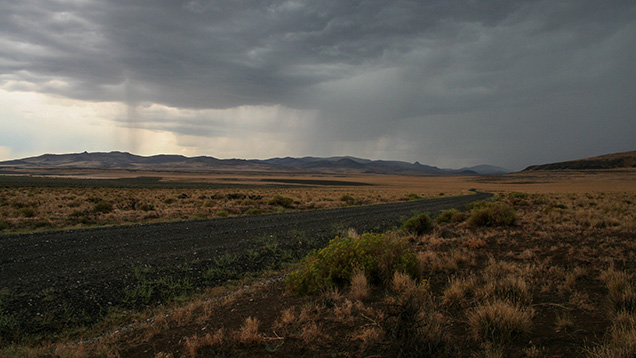What it Takes to Mine Oregon’s Sunstone
October 25, 2013

It’s easy to think of southeast Oregon as the state’s “empty quarter,” where the towns are few and far between and it’s hard to get a cell phone signal, but Kevin Schumacher, a GIA digital resource specialist and videographer, thinks the landscape and the people mining for sunstone there make a unique and remarkable combination to the gem and jewelry industry.
“The contrast between the tall trees at the Ponderosa and the broad, wide valleys and dark rolling volcanic hills near Plush was striking, although both areas have a rugged, distinctive beauty of their own,” he said.
And the people?
“These guys have an extra dose of character,” he said. “You need a multitude of skills to succeed in the desert and these folks really have it in spades. You have to be self-reliant … you need to prepare for the worst, but hope for the best.”
That’s especially true in “the valley,” the miners’ name for the Rabbit basin’s sunstone digging area, about 20 miles north of the tiny hamlet of Plush. The gravel roads there ‒ Hogback and the aptly named Nasty Flat ‒ are brutal on cars.
“Even to get there you need a tough vehicle,” Schumacher said. “Terry Clarke at the Dust Devil mine took one disdainful look at our SUV’s tires and told us to get 10-ply rather than the 4-ply next time.”
They found out he was right when their SUV suffered a puncture close to the Dust Devil mine. That’s when they got a glimpse of the miners’ true spirit and generosity.
“Whenever anyone’s in trouble, they’ll put aside any rivalries and help each other out,” Schumacher said. “These are not young guys anymore, yet they had that tire fixed in no time ‒ nothing was too much trouble.”


Schumacher watches as Dust Devil’s Terry Clark labors to fix a flat front tire on the team’s SUV. Photo by Duncan Pay/GIA.
The Logistics
“All my camera gear fits in a small suitcase, and that pretty much fits into a regular overhead locker on an airplane,” Schumacher said. “You have to check over all the equipment thoroughly ‒ charge the batteries, take spares, carry plenty of memory cards.”
“I would hate to get out there and find a dead battery, or find I’d forgotten something. I’ve no interest in being the weak link in the team!”
Schumacher said being a video cameraman is a far from passive pursuit. “I listen to every word the person on camera says during an interview. Any detail of the mining operation or landscape they mention, I’ll make sure I capture on film after we finish the interview.”
“That way, I can be sure the finished video conveys the whole experience of being there,” he said.


A view along Hogback road near the Plush sunstone area, not far from the Dust Devil mine. There was a downpour a little after this photo was taken. Photo by Duncan Pay/GIA.
And what of the journey out and back to the mines?
“The Ponderosa mine is about a six-hour drive from Portland and only the last little stretch is gravel roads. The Plush sunstone area is about a 150 miles further south, and a good stretch is gravel roads. The sunstone valley feels a lot more remote,” he said.
Remote and unpredictable. The group drove past brush fires further north, and a lightning storm lit the skies the last night at Dust Devil. The miners were a little concerned that they might have to pull out because of fires, but it eventually rained heavily, so the danger of fire was averted.
“The drive out from the Plush area was memorable,” Schumacher said. “The heavens opened and all the ruts on the gravel roads filled with water. Our truck was sliding around every time we touched the water, and we were a little concerned about the tire Terry patched, but we needn’t have worried, it held up all the way back to Portland!”
Lasting Impressions
“Each group of miners stuck in my mind ‒ they’re all wonderful characters,” Schumacher said. “I’ll always remember sitting around the campfire sipping cinnamon bourbon with John Woodmark’s crew at the Ponderosa at the end of the first day of our trip.”


Not all mining camp life is hard work. Everyone relaxes around the campfire at the end of the day to share experiences, have a drink and talk politics. Photo by Duncan Pay/GIA.
The next part of the visit with Don Buford, Terry Clark, and Mark Shore at Dust Devil was equally memorable.
“Don and Terry are Vietnam veterans ‒ they choose to live in the desert for half of the year because it suits them ‒ they love mining and they’re invested in making Oregon sunstone an American success story.”
“They showed us every facet of their operation, shared the ups and the downs, the challenges they still face every day they mine here,” he said.
Schumacher was amazed how the miners use the smallest of signs to discover gems.
“They’ll look for tiny sunstone fragments in ant hills and differences in the vegetation,” he said. “Sometimes they even walk the desert for months to find a good prospect. And once they find the gems, they’ve often got to get them out of pretty hard rock without breaking them into pieces.”
In the end, which experience will he remember most about the trip?
“I think actually trying our hand at mining at Dust Devil the old-fashioned way was pretty instructive” Schumacher said. “All of us were in the pit shoveling dirt through screens, and it’s not long before you realize what a lot of earth you’ve got to move to find anything at all. I was lucky; I found a couple of nice ‘reds’ ‒ the other GIA guys weren’t so fortunate!”
And the miners and the unique gems they seek?
“When we were leaving, Don shook our hands and told us we fit right in, which was the biggest complement he could have paid us,” Schumacher said. “I’d go back there in a heartbeat! Maybe I’ll do a little sunstone digging on my own.”



